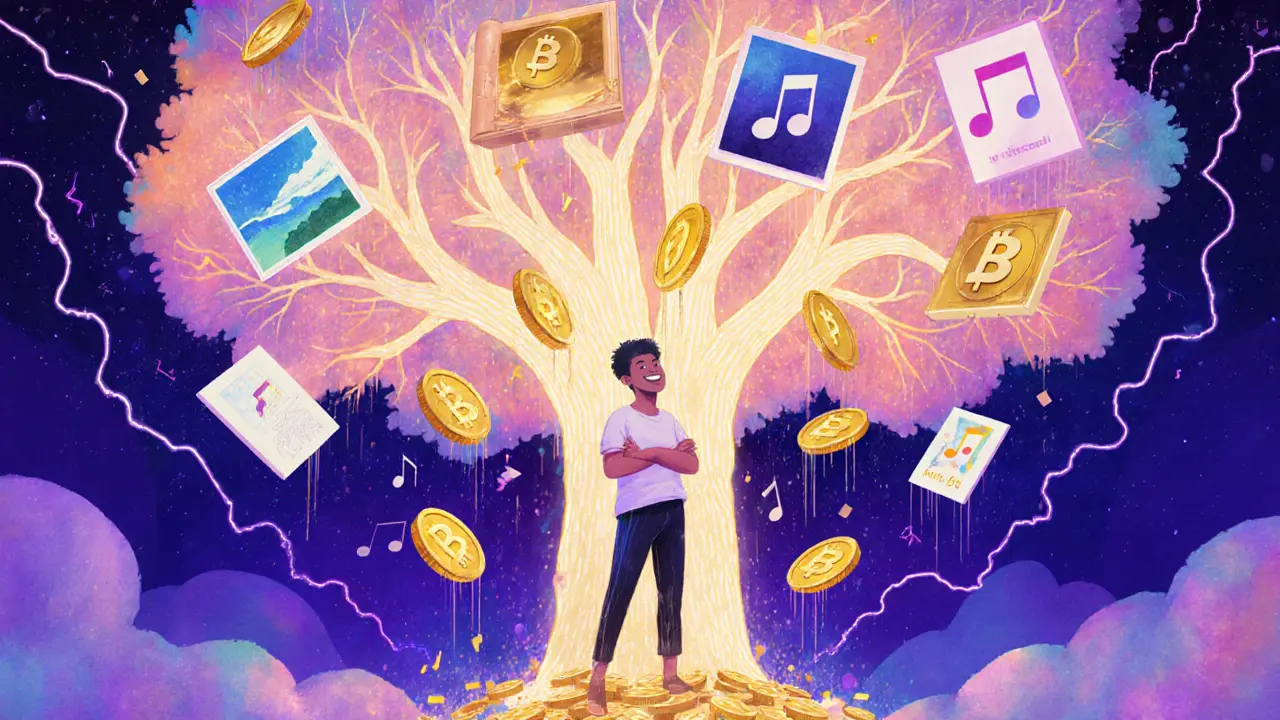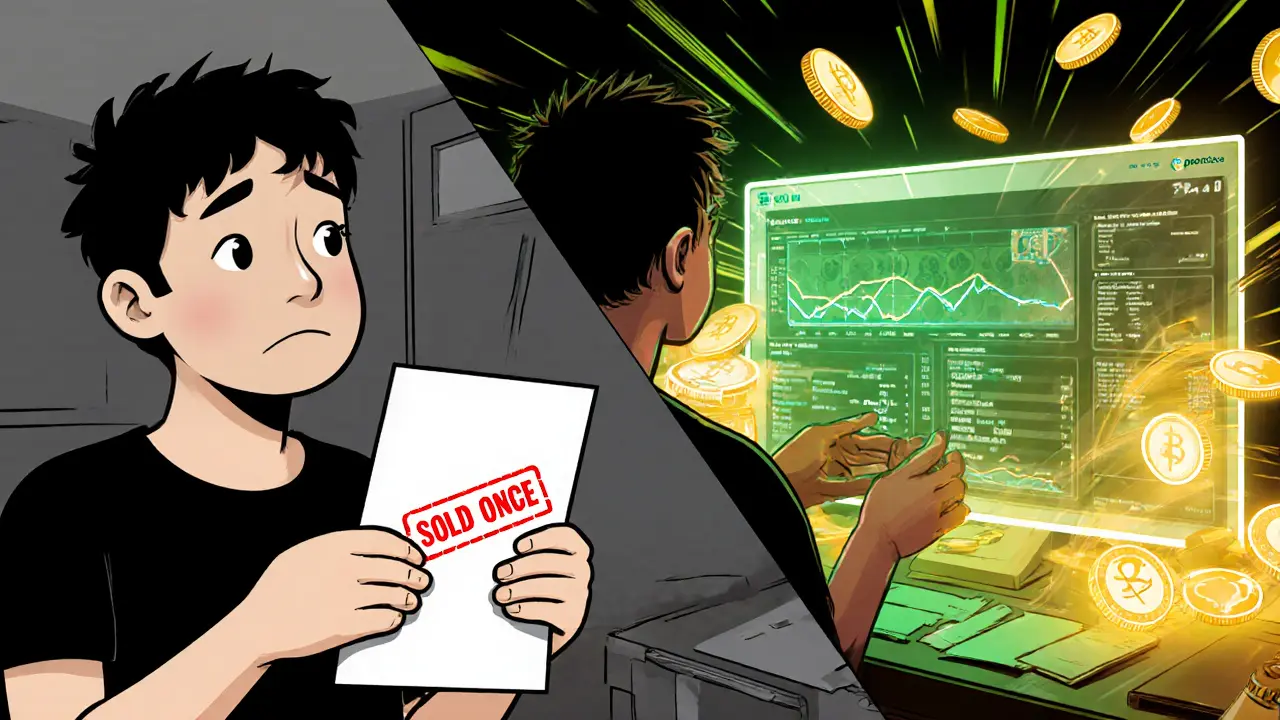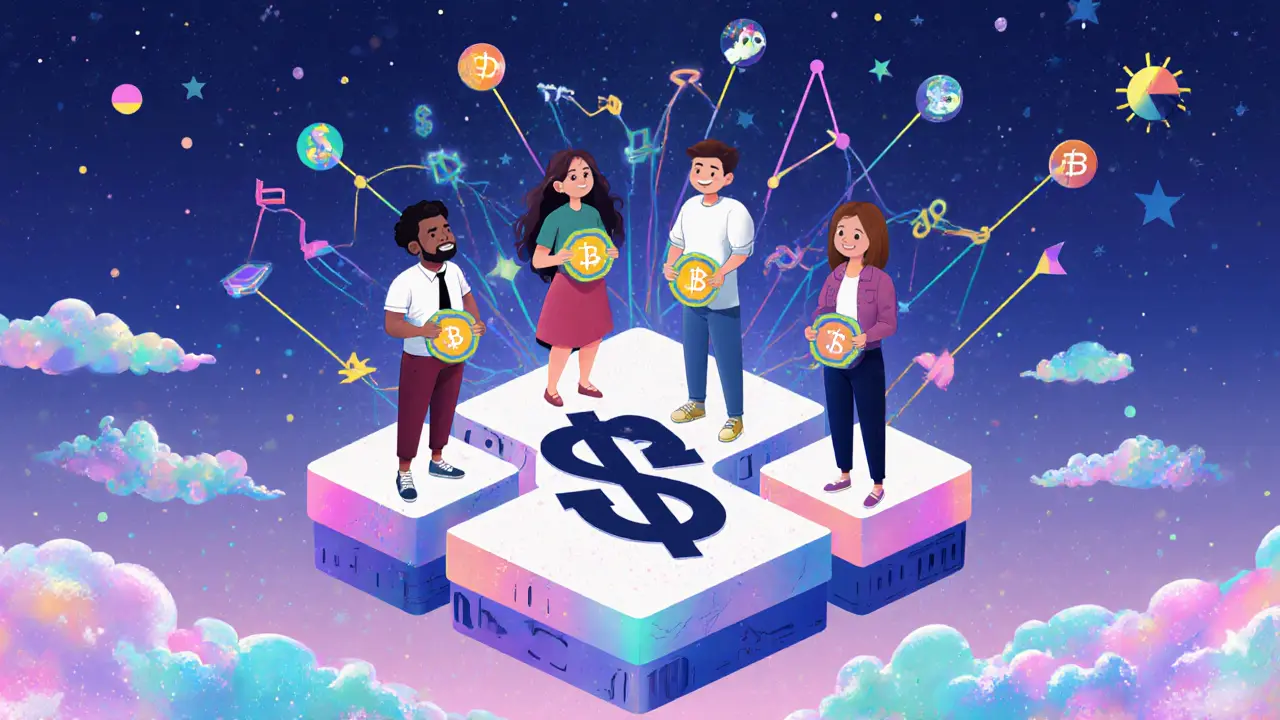
NFT Royalty Calculator
Calculate Your Royalties
How It Works
NFT royalties allow you to earn a percentage of each resale. Based on the article, successful artists typically set royalties between 5% and 7%.
Real Example:
From the article: An artist earned $16,037 in royalties from a single NFT file.
Your Royalty Earnings
Enter values to see your earnings
For decades, artists have been stuck in a broken system. You spend months creating a piece of digital art, upload it, sell it once - and then it’s over. Every time someone resells it for ten times the price, you get nothing. No cut. No thanks. Just silence. That’s the old way. But with NFTs, that’s changing. NFT royalties are giving artists a real shot at earning money every time their work changes hands - forever.
How NFT Royalties Actually Work
NFT royalties aren’t magic. They’re code. When you mint an NFT - turn your digital artwork into a blockchain-based token - you can set a royalty percentage right then and there. Most platforms let you choose between 5% and 10%. That means every time your NFT is resold on a marketplace like OpenSea or Blur, that percentage gets automatically sent to your wallet. No paperwork. No middlemen. No waiting for a check that never arrives.
This happens because of smart contracts - self-running programs on the blockchain. They don’t need humans to approve payments. They just do it. If your NFT sells for 5 ETH, and you set a 7% royalty, 0.35 ETH goes straight to you. The buyer gets the NFT. The seller gets their profit. And you? You get paid. Again. And again. And again.
Real Money, Real Results
This isn’t theoretical. People are making serious cash.
In 2022 alone, over $1.8 billion in NFT royalties were paid out on the Ethereum blockchain. That’s not a typo. $1.8 billion. Artists didn’t just get lucky - they built systems that kept paying.
Take Jacques Greene, a musician who turned a 6-second audio loop and GIF into an NFT. He made $16,037 in royalties from that one file. Compare that to his Spotify earnings: 7 million plays netted him less than half that amount. One tiny NFT beat millions of streams.
Big collections like Bored Ape Yacht Club paid out over $147 million in royalties to their creators. Art Blocks, World of Women, and VeeFriends? Each generated tens of millions. These aren’t outliers. They’re proof that the model works.
Some artists now make $5,000 to $10,000 a month just from royalties on their NFTs. They don’t have to post daily. They don’t need to run ads. They just created something once - and the blockchain keeps paying them.
Why This Is a Game-Changer for Digital Artists
Before NFTs, digital art was basically free. Anyone could screenshot it, repost it, sell it as a print, and you got nothing. The internet was built on copying. NFT royalties fix that.
Now, when someone buys your NFT, they’re not just buying a file. They’re buying a verifiable, blockchain-backed version - and they know you’ll keep earning from it. That actually increases value. Collectors don’t mind paying more if they know the artist benefits. It feels fair. It feels right.
And unlike traditional galleries, where you might get 50% of the first sale and nothing after, NFT royalties give you a share of the appreciation. If your art becomes a cultural icon - like a digital Warhol - you’re still in the game. You’re not left behind while collectors get rich.

Problems? Yes. But They’re Solvable
It’s not perfect.
Some marketplaces - like Magic Eden - let buyers opt out of royalties. That means if someone moves your NFT to one of those platforms, you might not get paid. And there are tricks - like “wrapping” NFTs - where people repackage them to bypass royalties entirely.
Some buyers hate high royalties. If you set it at 15%, they’ll walk away. Most successful creators stick to 5-7%. That’s enough to make a difference without scaring off buyers.
Also, not every platform enforces royalties the same way. OpenSea does. Blur does. But if your NFT ends up on a shady, unregulated site? You might lose out. That’s why many artists now use allowlists - only allowing sales on trusted platforms.
But here’s the thing: the industry is catching on. More platforms are starting to enforce royalties by default. The pressure from creators is working. This isn’t a glitch - it’s a transition.
What You Need to Do to Start Earning Royalties
You don’t need to be a coder. You don’t need to understand blockchain.
Here’s how to start:
- Choose a platform that supports royalties (OpenSea, Foundation, SuperRare, or Blur).
- Mint your artwork as an NFT.
- During the minting process, set your royalty percentage - 5% to 7% is the sweet spot.
- Wait for your first sale. Then, wait for the second. And the third.
That’s it. The system handles the rest. You’ll get notifications when payments come in. You can track every resale on Etherscan or your wallet dashboard. No guesswork. No drama.
And if you’re worried about gas fees or complexity? Most platforms now have one-click minting. You upload your file, set your price, set your royalty, and click “Create.” Done.

It’s Not Just About Art
NFT royalties are spreading beyond digital paintings.
Musicians are using them for tracks, loops, and samples. Writers are locking royalties on digital books and short stories. Game developers are embedding royalties into in-game items. Even photographers are selling limited-edition NFTs with built-in royalties.
This isn’t a trend. It’s a new economic layer for creativity. The internet used to reward views and clicks. Now, it’s starting to reward actual value - the kind that lasts.
What’s Next for Artists?
Right now, you’re at the beginning of something big. The old art world - galleries, auctions, middlemen - still exists. But it’s losing ground. Artists who use NFT royalties are building independent careers. They’re not waiting for permission. They’re not begging for grants. They’re earning directly from their audience.
In the next few years, we’ll likely see:
- More platforms enforcing royalties by default
- Legal frameworks protecting creator royalties across borders
- Multi-creator splits - where a team of artists, designers, and coders all get paid automatically
- Royalties extending to AI-generated art, where the human creator still owns the output
This isn’t about getting rich overnight. It’s about building a sustainable career. One that doesn’t vanish when the algorithm changes or the platform shuts down.
For the first time, digital artists have real control. Not over the internet. Not over trends. But over their own income. And that’s powerful.
Do NFT royalties work on all marketplaces?
No. Some platforms, like Magic Eden, allow buyers to disable royalties. Others, like OpenSea and Blur, enforce them by default. To protect your income, mint on platforms that support enforced royalties and consider using allowlists to restrict sales to trusted marketplaces.
What’s the ideal royalty percentage for artists?
Most successful creators set royalties between 5% and 7%. Higher percentages (like 10% or more) can scare off buyers, especially investors looking for quick flips. Lower percentages (below 5%) may not generate meaningful income. 5-7% strikes the right balance between fair compensation and market appeal.
Can I change my royalty percentage after minting?
Generally, no. Once an NFT is minted, the royalty percentage is locked into the smart contract. If you want to change it, you’d need to create a new NFT collection. That’s why it’s important to choose your percentage carefully before minting.
Do I pay taxes on NFT royalties?
Yes. In most countries, NFT royalties are treated as income. You’ll need to report them on your tax return. Keep records of every payment you receive, including the date, amount, and platform. Some creators use crypto tax tools like Koinly or CoinTracker to automate tracking.
Are NFT royalties only for visual art?
No. Musicians use them for audio files, writers for e-books, game developers for skins and items, and even photographers for limited-edition digital prints. Any digital creation that can be tokenized can carry royalties. The technology is designed for any form of digital intellectual property.


Comments
Angie McRoberts
Just minted my first NFT today. 6% royalty. Fingers crossed.
Nitesh Bandgar
THIS IS THE REVOLUTION WE’VE BEEN WAITING FOR!!! No more starving in a studio while some hedge fund guy flips your soul for 50 ETH!!! I cried when I saw my first royalty hit-0.12 ETH!!! After 12 years of being ignored!!!
Allison Doumith
It’s not about the money it’s about the dignity
Before NFTs your art was a screenshot
Now it’s a legacy
And that changes everything
You’re not selling pixels you’re selling proof that you existed
And that you matter
Sunidhi Arakere
Good for artists. But what about buyers who don’t want to pay extra fees? Shouldn’t they have choice?
Vivian Efthimiopoulou
The structural shift here is profound. We are transitioning from a consumption-based digital economy to a stewardship-based one. Royalties are not a feature-they are a reclamation of labor value. The blockchain, in this context, is not a speculative ledger but a covenant between creator and collector. When you buy an NFT with embedded royalties, you are not merely acquiring an asset-you are entering into a symbiotic relationship where appreciation is shared, not extracted. This model mirrors the feudal patronage system, but decentralized, transparent, and irreversible. It is the first time in modern history that the producer of cultural value is structurally guaranteed a stake in its enduring legacy.
Fred Kärblane
Let’s be real-this is the only way digital creators survive now. Spotify pays pennies. Instagram eats your content for free. TikTok steals your sound. But NFTs? They actually pay you when your work becomes iconic. I made more from one 8-bit pixel cat than I did from 5 years of freelance design. This isn’t crypto bro nonsense-it’s economic justice.
Chloe Walsh
They say it’s fair but what about the people who bought the NFTs thinking they owned the art and now they’re stuck paying some artist forever like it’s a vampire mortgage?? I just want to resell my Bored Ape without feeling guilty like I’m stealing from someone’s child’s college fund
gerald buddiman
Wait-so if I buy a piece and resell it, the artist gets paid again? That’s… kind of beautiful? I didn’t think crypto could do something this human. I’ve been skeptical for years, but this? This makes me want to support artists again. I just bought my first NFT. 7% royalty. Let’s go.
Noah Roelofsn
Don’t fall for the hype-royalties only work if the platform enforces them. OpenSea? Yes. Magic Eden? No. And don’t even get me started on cross-chain swaps or wrapped NFTs. I’ve lost royalties three times because someone moved my art to a shady marketplace. Always check the marketplace’s royalty policy before buying or minting. And use allowlists. It’s not enough to mint-you gotta protect your income like a dragon guards its hoard.
Diana Smarandache
While the concept of automated royalties is commendable, it is not without significant legal and ethical ambiguities. The enforceability of smart contract royalties across jurisdictions remains untested. Tax authorities in the U.S., EU, and India have not yet established clear frameworks for treating these payments as earned income. Furthermore, the moral hazard of perpetual compensation-where creators receive royalties indefinitely regardless of market demand-may distort artistic incentives. Is the artist creating for legacy, or for passive income? The answer may redefine the nature of creativity itself.
Meagan Wristen
I love how this is helping marginalized artists-especially women and nonbinary creators-who were ignored by galleries for decades. I’ve seen so many friends finally make rent because of their NFT royalties. It’s not perfect, but it’s the first time the system actually worked for them. Keep going.
Alexa Huffman
My mom just asked me if NFTs are like digital paintings. I showed her my royalty dashboard. She cried. She said, ‘I never thought your art would pay for itself.’ That’s the real win here.
Janna Preston
What if I’m not an artist but I want to support one? How do I find good NFTs with royalties?
Grace Huegel
It’s poetic, really. The same technology that enables speculative mania also restores dignity to labor. But I won’t be fooled. The market will crash. The platforms will change. Royalties will be hacked or ignored. And when that happens, the artists who built their lives on this will be left with nothing but a blockchain receipt and a broken dream.
Angie Martin-Schwarze
i minted my first thing last week and got 0.03 eth in royalties yesterday and i just cried in my kitchen like a weirdo
it’s not much but it’s mine and no one can take it